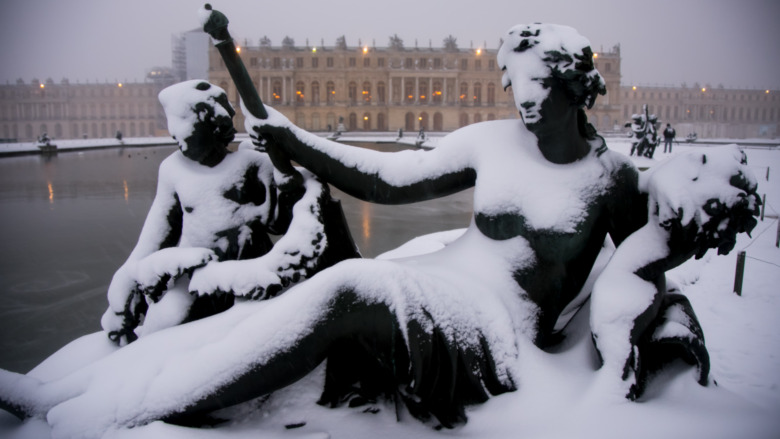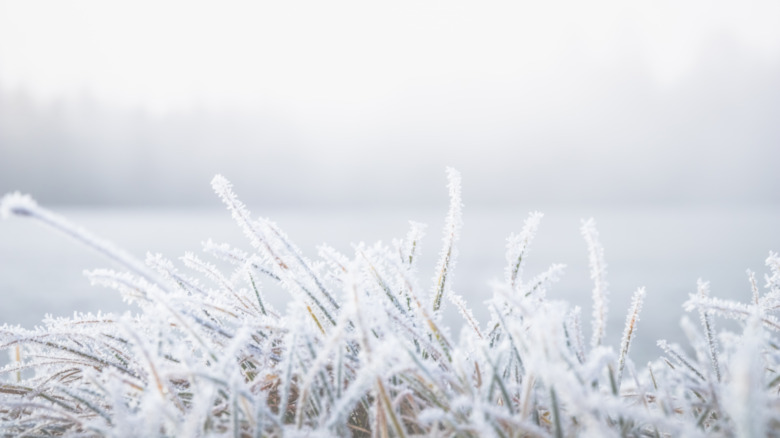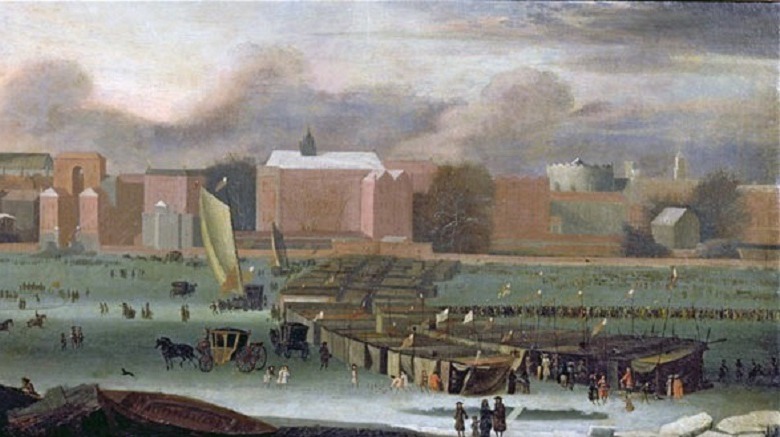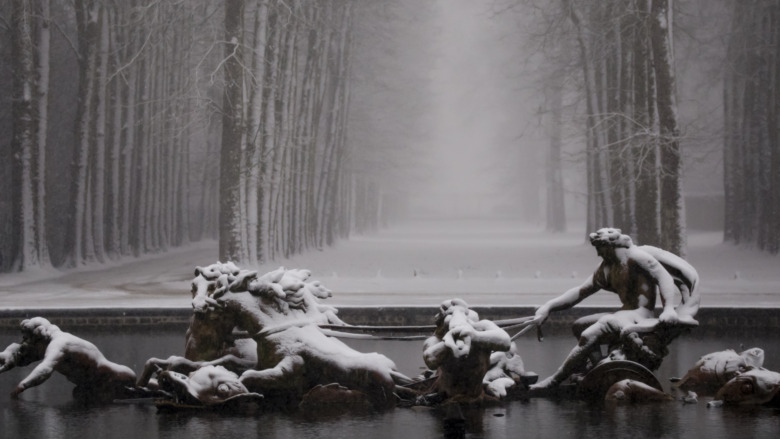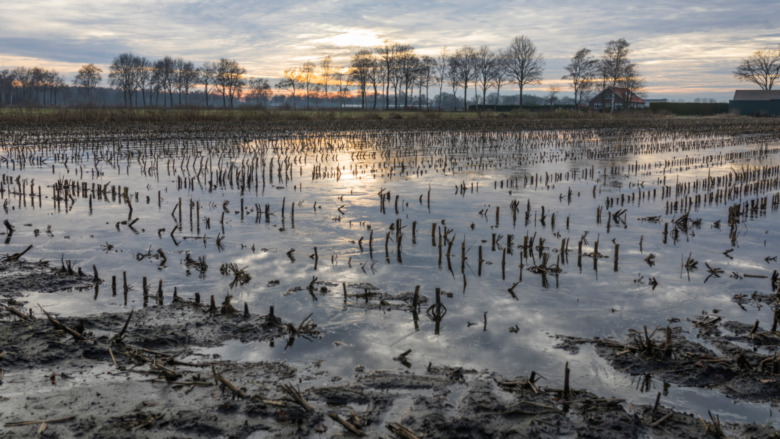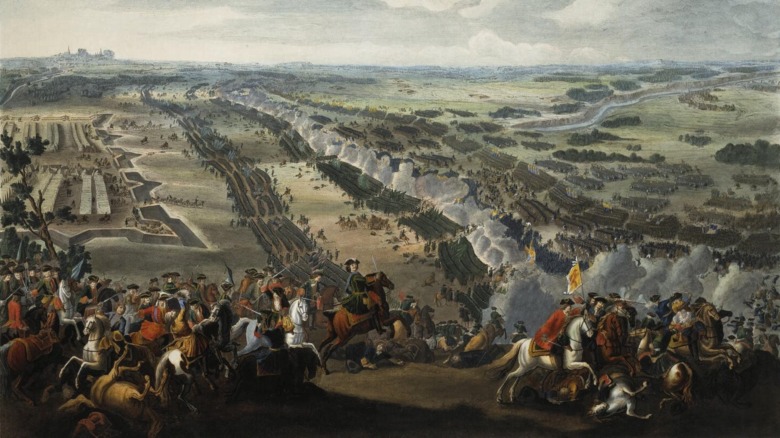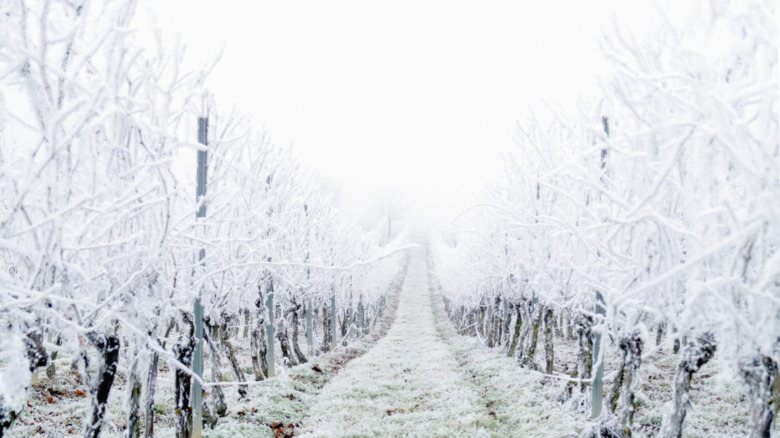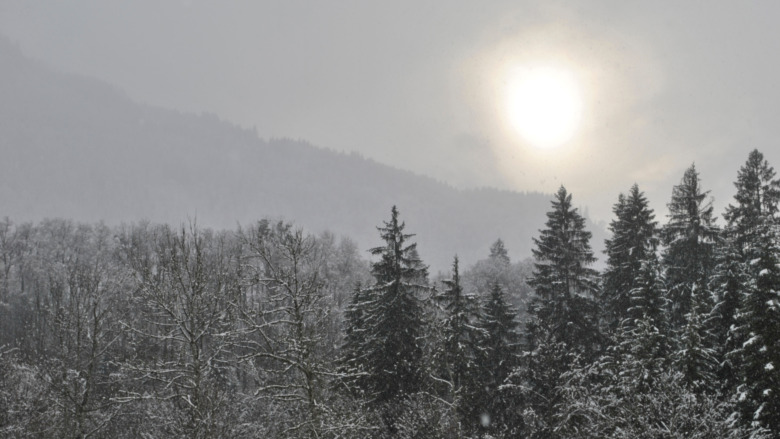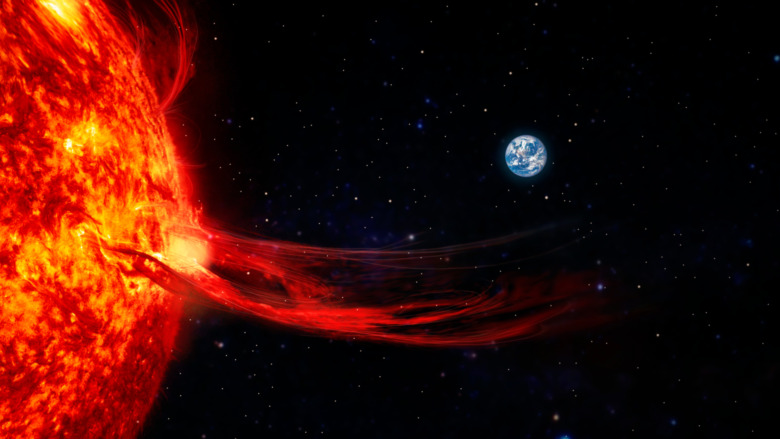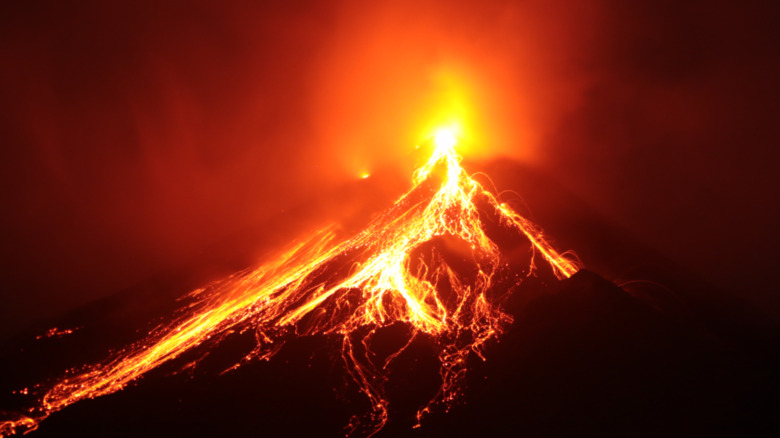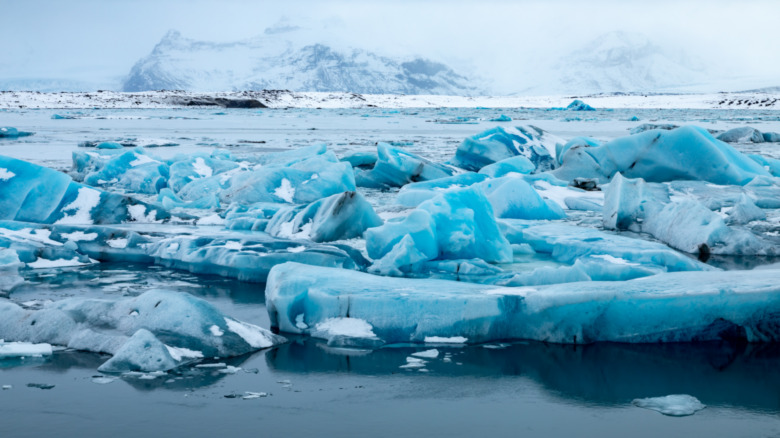The Deadly Great Frost Of 1709 Is Still A Mystery
There's cold, and then there's really cold. Cold is the sort of thing you feel when it's the middle of the winter and — no matter where you live — you're forced to wear a couple extra layers of clothes, and maybe dig out the boots. It's when a scarf is practical, and not just a fashion statement. Then, there's really cold: that's the sort of cold that the residents of Oymyakon, Russia deal with on a daily basis. The average temperature there is around -58 Fahrenheit, and that's unimaginable to anyone who hasn't experienced it.
The hardy citizens of the coldest place on Earth are prepared for it, though, and they've made survival into an art form that uses fur and booze as its medium. But what about places that aren't prepared for relentless cold that lasts for months ... and months ... and more months?
In 1709, people across Europe were faced with something dire: below-freezing temperatures that just didn't break. It lasted for months, and facing it had to seem apocalyptic. There was, after all, no global weather forecast that could assure them that it was going to get warm again — someday. There was just the cold, day after day. There was no system in place to warn them about it, either. One morning, everyone just woke up to a frozen world... and no one knows why.
The Great Frost literally happened overnight
It was called the Great Frost in England and Le Grand Hiver in France, but whatever anyone wanted to call it, it basically meant it had become insanely cold. And yes, it literally happened overnight. When people across Europe went to sleep on the evening of January 5, 1709, they couldn't possibly have known what they were in for. When they woke the next morning, National Geographic says that the temperature had plunged to the very bottom of the thermometer. The snows started and didn't stop, and suddenly, this new, snow-covered world was an average temperature of about -5 Fahrenheit.
(Let's mention what that number means. According to LiveScience, frostbite can happen in as little as 10 minutes when a person is exposed to temperatures around 0 Fahrenheit with a wind chill factor. Hypothermia — a cold-induced critical failure of the body — can happen in the same amount of time when the temperature drops just a bit more to -30 Fahrenheit.)
Today, we can check the weather for the week and know that while it might not be precisely, 100% accurate, we can get a pretty good idea of what's in store. In 1709, though, there was no warning. Thousands and thousands of people died from hypothermia before anyone realized how serious the plummeting temperature was, and animals — including valuable food sources like chickens and cows — froze to death where they slept. And that was just the beginning.
How cold was cold?
The temperature didn't just drop in 1709, it stayed below freezing for months — and as the days dragged on, people and animals alike continued to struggle.
Parisians, says National Geographic, were left to fend for themselves for three months — with no supplies able to get in. Snow blocked roads across the continent, and rivers — including the Thames, Garrone, and the Rhone — froze with up to 11 inches of ice. Germany's hot springs froze, too, along with Amsterdam's canals, Switzerland's lakes, and the Adriatic and Baltic Seas. Those frozen lakes allowed starving people and animals to walk across them in search of food ... and as food was scarce, sometimes, the frozen bodies of the dead became dinner. The freeze was relentless: the Baltic Sea remained frozen solid for around four months.
There are accounts of the cold being so complete that trees cracked and shattered spontaneously, and church bells even stopped ringing, because they'd break and crack. Wine froze in the wine cellars of the rich, along with bread, meat, and what little food remained. And as for drink? Wells froze solid, and the only things that remained liquid were hard liquors, like whiskey. And when it came time to find food, Historia says that the cattle and other large animals were the first to die. Small wild animals — like hares and game birds — and large — like deer and wild boar — were decimated, and entire populations were wiped out.
Rich and poor alike all suffered
History hasn't really had a great track record when it comes to treating the world's poorest people and littlest residents with any kind of respect — just look at jobs like the olde-timey chimney sweep. So, it's not entirely surprising to learn that National Geographic says that yes, Europe's poorest residents often died where they slept. Slightly more surprising is that the rich didn't seem to have it much better, for a strange reason.
Europe's elite had spent a good long time building massive, sprawling palaces for themselves, on huge estates that concentrated more on decoration than practicality — practicality was, after all, something that the servants needed to concern themselves with. Take Versailles. Louis XIV turned his father's hunting lodge into a palace in the 1670s, and when he did his upgrade, he added a lot of windows. Tall, wide, massive windows that were designed specifically to be impressive.
Anyone who's ever held their hand up to a modern window when it's cold outside knows how chilly it gets, and that was the problem. In the midst of the cold snap, the Duchess of Orleans was staying at Versailles, and wrote: "The cold here is so fierce that it fairly defies description. I am sitting by a roaring fire, have a screen before the door, which is closed, so that I can sit here with a fur around my neck ... and I am still shivering and can barely hold the pen. Never in my life have I seen a winter such as this one..."
How long did Europe feel the consequences?
This is one of those questions that's difficult to answer, aside from, "A long, long time." It wasn't just a cold spell: Historia says that the winter of 1709 included the coldest month the continent had seen in 500 years. That was followed by six more cold snaps where temperatures once again plummeted, and these freezing conditions lasted until March. By then, the ground was frozen, entire forests of trees were dead, and when temperatures finally rose again, snow and ice melted to create devastating floods. Crops that should have been growing by spring were lost, starvation continued, and that's when the revolts began.
Between February and June of 1709, there were 155 instances of open rebellion in France alone, as starving people descended on any building — particularly castles and religious institutions — that might have food left. Famine became just as bad as the cold, and according to one letter written by the sister-in-law of the French king, by June it was so bad that "children have devoured each other."
It's almost impossible to measure the long-term effects of such devastation, but when The Guardian took a look at what happened in England in the years following the freeze, they found that the country's entire agricultural economy had been destroyed, their GDP went down by a shocking 23%, and it was around 10 years before the nation saw anything close to a rebound to pre-freeze conditions and productivity.
Would Russia have become a super power without it?
Different historical events are connected in a lot of really weird ways, and it's entirely possible that if the Great Frost of 1709 had never happened, Russia might not have become a world superpower.
The whole thing goes back to the beginning of the century, and the Great Northern War. According to Medium, this was the war that decided how the balance of power was going to fall, and it was down to Sweden and Russia. At the time, Peter the Great's Russia had been advancing fairly regularly on Sweden, which was headed by the barely-out-of-his-teens Charles XII.
The two had been trading blows for some time, and during the Great Frost of 1709, National Geographic says the Swedish army — which was already smaller — suffered devastating losses. Around 20,000 Swedish soldiers died, and there were some nights that saw as many as 2,000 men dying before the sun rose. Add in a lack of supplies that weakened those who did survive, and that lead-up to the Battle of Poltava crippled the Swedish forces. Ultimately, the June confrontation ended with Sweden getting a sound trouncing and Peter? He got even Greater. It's that fight that's credited with being one of the key moments in history that led to the rise of Russia as a superpower, so ... would it have happened without the cold snap?
No one's really sure how many people died
When Meteo France spoke with historian Emmanuel Le Roy Ladurie about The Great Winter, it quickly became clear that for all we know about the terrible cold spell, there's plenty we don't know — like how many people died. In the 1709 La clef du cabinet there's this observation: "An infinite number of people ... died everywhere ... whole families were found to be frozen to death."
Deaths didn't just come with the cold, either, and for those who survived, there were other difficulties lurking in the months ahead. E. Le Roy Ladurie says that it's estimated around 100,000 people died immediately from the cold — and we're only talking about France here. Then, as many as 200,000 who died in the famine that followed, and after that, there was another round of about 300,000 deaths.
That last set of deaths didn't stop until 1710, and these were the people who were already weakened and succumbed to diseases — like typhoid, smallpox, measles, dysentery, and even scurvy — that they may not have been vulnerable to otherwise. There was also widespread death that came from eating spoiled food — and from eating things that just aren't suitable as food, like carrion. Historia says there were other causes of death, too. Suicide wasn't uncommon, and people died in the riots that broke out across the country, too. All that leads to an almost unimaginable 600,000 deaths ... again, that's give or take an unknown number, and that's in France alone.
The Maunder Minimum
The biggest mystery of all is what caused this plunge into wave after wave of sub-zero temperatures in the first place?
According to National Geographic, one of the oft-touted suggestions is that it had something to do with a phenomenon called the Maunder Minimum. That's technically something that happened between 1645 and 1715, and NASA described it as a time when the sun "entered a quiet phase." The sun, they say, actually got dimmer, and there was less activity seen across the surface of it. Fewer sunspots, the theory goes, resulted in less output, and that meant the temperatures dropped across everything the sun was shining on.
It's insanely complicated, but the theory put forward by some climate scientists basically suggests that a decrease in energy received from the sun meant the formation of less ozone, which in turn impacted weather patterns like the jet stream. That, in turn, impacted the presence of low- and high-pressure systems, and resulted in particularly bad weather for that particular year. Makes sense, right? Not everyone thinks so, and it's still debated just how much a slight temperature change from the sun can impact our planet's weather.
Just how much does the sun's output impact the planet?
While it makes some seriously logical sense that a cooler sun would make for a cooler earth, it's not that straightforward. While some researchers — like Valentina Zharkova of Northumbria University — suggest decreased sunspot activity and solar radiation will lead to colder temperatures for us, others aren't so sure. Georg Feulner of the Potsdam Institute on Climate Change Research reports (via LiveScience) that his research shows that the sun's output and surface activity has an "insignificant" impact on Earth's overall temperature — especially when compared to global warming and the impact that humankind has been having on the atmosphere, climate, and overall livability of this big green-and-blue marble we're all clinging to.
Feulner suggests that another period of decreased activity — like the one seen around the deep-freeze of 1709 — would only lower the average temperature about .1 degree Celsius. That's pretty negligible, and he's not the only one saying that the sun is the least of our worries.
In other words, if that climate model is to be believed, that puts everyone back at the drawing board for coming up with what the heck caused the Great Winter. Just as importantly, if we can't figure this one out, how can we keep it from happening again? Inquiring minds would really like to know.
Here's what past patterns suggest
There's also the suggestion that the Maunder Minimum and decreased activity from the sun had something to do with it ... but not everything. In 2010, NASA's Ames Research Center solar physicist David Hathaway wrote that "there is good evidence, to some extent" that activity on the sun's surface might cause fluctuations in the Earth's temperature, and here's the thing: these sun cycles happen pretty regularly, and they're always slightly different.
These sun cycles happen about every 11 years, but they're always variable — and while it's impossible to know, some scientists suggest (via LiveScience) that there was a period of around 70 years when sunspot activity nearly stopped — and it was a period that corresponded not only with cold years, but the so-called Little Ice Age.
Robert McLachlan, a professor in Applied Mathematics at Massey University, told The Conversation that this 11-year sun cycle has been happening pretty regularly for hundreds of millions of years, and that no, we're not entirely sure what makes it happen and what the long-term, far-ranging impacts are. And here's the thing: we've seen both "strong" and "weak" sun cycles in recent memory, including a strong one in the decade between 1954 and 1964, and a weak period between 2009 and 2019. We didn't have another Little Ice Age ... so what gives?
Were volcanoes responsible for the cold winter of 1709?
There are a few other suggestions about what caused the Little Ice Age, along with the devastation that came with that particularly cold winter in 1709. First, says the BBC, there's a theory that suggests it all began about four centuries earlier, with a series of volcanic eruptions that started at the end of the 13th century.
That's the result of a study done by the University of Colorado, which found it was possible that four massive volcanoes — which erupted between 1250 and 1300 — filled the atmosphere with so much debris that it reflected solar energy away from the planet and kicked off a long game of lowering temperatures that resulted in an expansion of the polar ice caps and — in turn — that caused temperatures to keep going down.
While they say that it's impossible to calculate with any certainty just what kind of impact that would have had on climate — and how long it would have lasted — it's entirely possible that a short burst of really cold weather was enough to kick-start the Little Ice Age. Maybe. Others are doubtful, saying that the cooling period just wouldn't have been enough to make the sort of difference the world saw.
Or, did it just kind of happen?
Not everyone's happy with that theory, either: researchers from NORCE Norwegian Research Center suggest (via Science Norway) that it might be more accurate to use that old phrase of "poop happens." They say that "Sometimes, climate models behave strangely," and there's no rhyme or reason for why things happen. They even have a name for these particular instances: they're called "ugly ducklings," because they seem to be completely wrong... but they might not be.
Just because we don't completely understand it, the theory goes, that doesn't mean it didn't happen. There's plenty we still don't know about our world — just look at all the sea creatures we're only finding out about now, and Cthulhu can't even hold a candle to some of them.
When this group of researchers looked at weather patterns from the beginning of the Little Ice Age, they found evidence that a huge section of sea ice had left the Arctic Ocean and headed for warmer climates. Why? Who knows! That icy migration continued for the next 100 years, and they suggest the impact that had on ocean currents and winds would have been enough to kick-start the Little Ice Age. Bottom line? The world is weird, life is unpredictable, and we're just along for the ride.
